|
|
Post by chasensfo on Nov 29, 2022 1:53:01 GMT -5
Air Calypso repaint links added, Garuda 747-300 Corsair hybrid repaint link added. \\LTU International 1998 v3 (28NOV22; added variations by ludo66x and changed the Commander and Cessna to "Registration" callsigns instead of flight numbers like real life). LTU International (1955-2009) IATA: LT ICAO: LTU CALLSIGN: LTU LTU International operated by Rheinland Air Service (1990s; dates unknown) IATA: RW ICAO: RLD (Also use "LTUX" for parking) CALLSIGN: RHEINLAND LTU International operated by LuftTaxiService (c.1995-2001) IATA: NONE LISTED ICAO: NONE LISTED (use "LTUX" for parking) CALLSIGN: NONE LTU International operated by Flugdienst Carlos de Pilar (1990s; dates unknown) IATA: NONE LISTED ICAO: NONE LISTED (use "LTUX" for parking) CALLSIGN: NONE LTU International was a Dusseldorf (DUS)-based German leisure airline that grew to be one of the largest carriers in Germany. LTU International started life in 1955 as a Frankfurt (FRA)-based company named Lufttransport Union offering scheduled flights with Vickers Viking 610\621s. The following year, the airline began international charter flights and rebranded as LTU International and a lone Bristol 170 briefly joined the fleet. A pair of Douglas DC-4s arrived in 1958, capable of performing longer nonstop routes with more passenger comfort, and the airline expanded to more leisure destinations across Western Europe and the Mediterranean. 2 years later in 1962, LTU got its first modern aircraft with the arrival of a Fokker 27-200 "propjet". Soon after in 1964, LTU added its first jets with the first of 7 SUD Caravelles arriving followed a few years later by Fokker 28-1000s. LTU was an early customer for these aircraft, which allowed the carrier to offer the same comfort and convince rivals Lufthansa and Condor on similar routes. These aircraft wore the iconic red and white livery which LTU would keep variations of for most of its existence. The first widebody long-haul jets arrived in 1975 when L-1011s joined the fleet, eventually becoming the backbone of the airline through the 1990s. These aircraft were based in DUS, which had become the new headquarters for the carrier, and enabled services to North America, Asia, and the Caribbean. In 1983, LTU started a Munich (MUC)-based subsidiary called Lufttransport Sud, or LTS. LTS began with brand new Boeing 757-200s, for which LTS was one of the first operational customers, and flights began in 1984 with a white and blue livery. LTS hired its own staff, at lower wages than LTU, with hopes of more flexibility for growth and expansion. 767-300s arrived soon after, and the subsidiary rebranded as LTU Sud, changing the blue colors in their livery to red to better match the parent company LTU. Around the same time, 3 757-200s were used to start another subsidiary called Lineas de Transportaciónes Españolas, or LTE, based in Palma de Mallorca (PMI). LTE aircraft wore the basic livery as LTU, but with LTE titles, focus cities were set up in Las Palmas (LPA) and Tenerife Sud (TFS). By this time, MD-11s had already joined the LTU fleet, followed by A330-300s in 1995. As such, LTU focused on the medium and long haul until the late 1990s, leaving much of the short/medium haul flying to LTS. LTU by this time had a large long-haul network, serving points as far away as Los Angeles (LAX) and San Francisco (SFO), Windhoek (WDH), and Bangkok (DMK). As the 90s progressed, LTU made the decision to absorb LTU Sud into the mainline operation and begin to retire L-1011 Tristars in favor of more efficient 767-300s, which were transferred over quickly starting in 1997. In 1998, LTU Sud was closed and the aircraft began to appear in the standard LTU livery, though some flew for a few years in the LTU Sud colors. By then, all the L-1011s had been retired and the long-haul fleet was now made up of MD-11s and 767s, while 757s and A330s did the short and medium-haul routes. LTU had amassed a huge network, connecting many cities in Germany both large and small to leisure destinations across Europe. Long-haul flights mostly operated from DUS, FRA, and Munich (MUC). As the L-1011s were replaced, some long-haul destinations like SFO that were on the edge of the capabilities of the 767s but deemed to not be a good use of MD-11s were dropped, but a weekly route to Phoenix (PHX) was started. Some cities such as Reykjavik (KEF) saw a weekly flight late at night, while others like Palma de Mallorca (PMI) saw several daily flights. In addition to these flights, LTU had signed agreements with 3 German commuter carriers to feed its DUS hub. LuftTaxiService, also known as LTS, was flying Cessna 402 Golden Eagles to Paderborn (PAD), Flugdienst Carlos de Pilar was operating Turbo Commanders to Saarbrucken (SCN), and RAS Flug was operating Shorts SD3-60s to a few destinations including linking Dusseldorf's smaller Monchengladbach Airport (MGL) with the DUS hub. At the time, RAS Flug was operating 100% of its flights as an LTU commuter carrier with just those 2 aircraft making up it's entire fleet (though the company lives on today as an aviation management company). The first A320 arrived in time for the summer 1999 season, wearing the standard livery, though many to follow would wear special liveries with white fuselages with a red belly and tail. LTU would soon after get rid of the MD-11s in favor of more Airbus A330s and add 11 A320s and 4 A321s to the fleet. In 2007, the Air Berlin Group acquired LTU, initially allowing LTU to operate some routes independently while rebranding others. In 2009, LTU was fully absorbed by Air Belin, who continued operating the DUS long haul hub, along with a smaller one in Berlin Tegel (TXL) until that carrier failed in 2017. Flightplans by Vireak Ball and myself. Like most charter airlines which often ferry aircraft, the schedule leads to many extra aircraft. I patched together what I could, and ended up with an extra aircraft which I assigned to the A320 which arrived in 1999. You may make this a 757 if you wish. P3D Fleet paints by Michael Pearson may be found here: drive.google.com/drive/folders/1oEI0bJk-4A8ofKgYX_bgp2RYuOOUjoReCommuter fleet by RAI member ludo66x here: drive.google.com/drive/folders/1VMbXiI0Jg1ONUMqfuFBVauzHAziqApv_ MD-11: 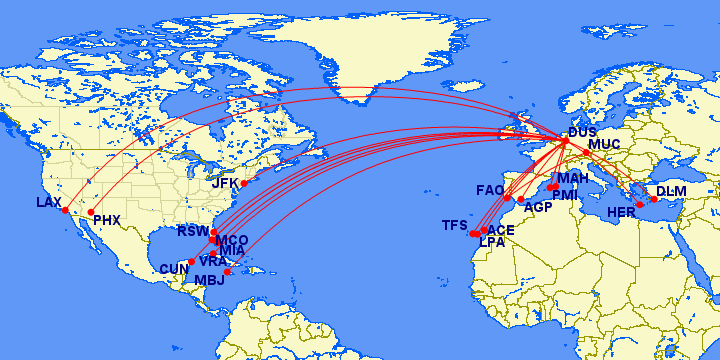 A330-300: 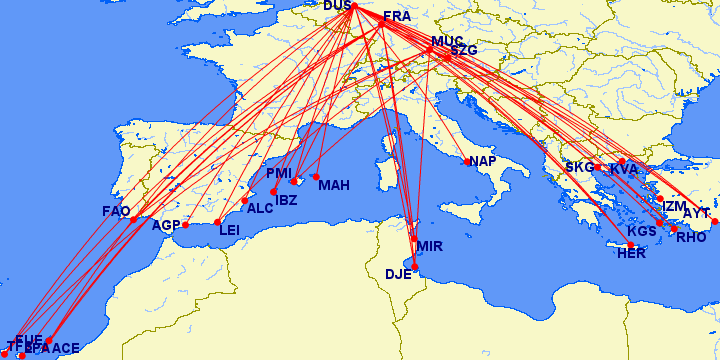 767-300: 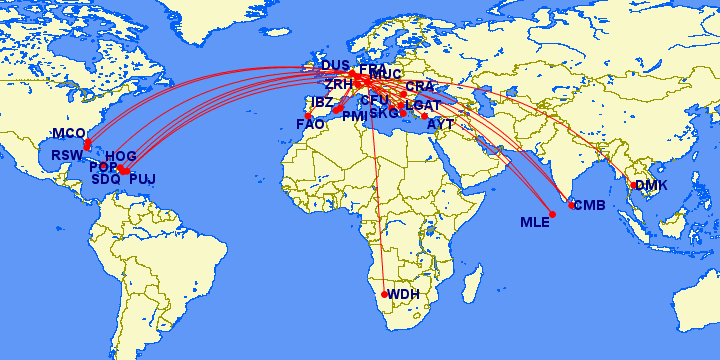 757-200: 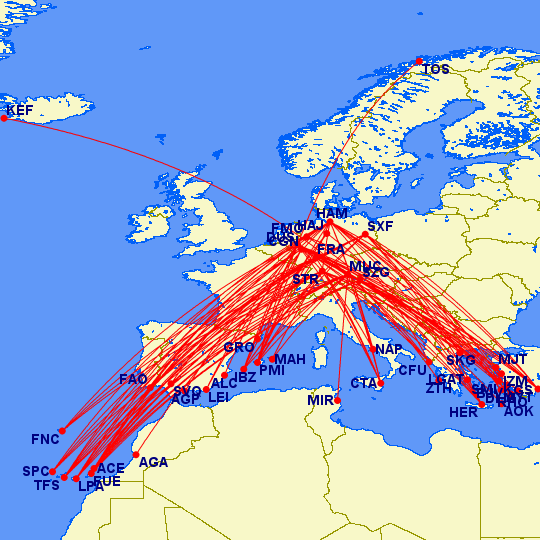 Shorts SD3-60 operated by RAS Flug: 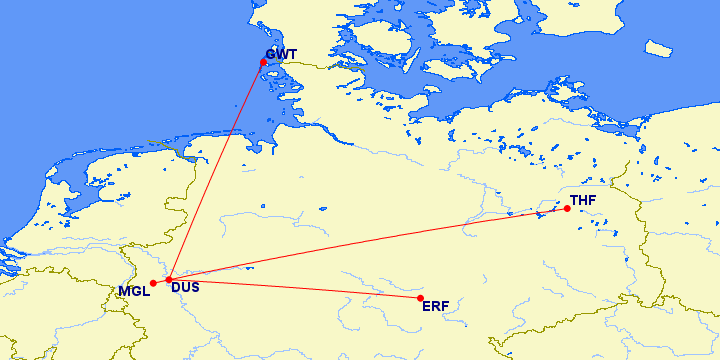 Cessna 421C Golden Eagle operated by LuftTaxiService: 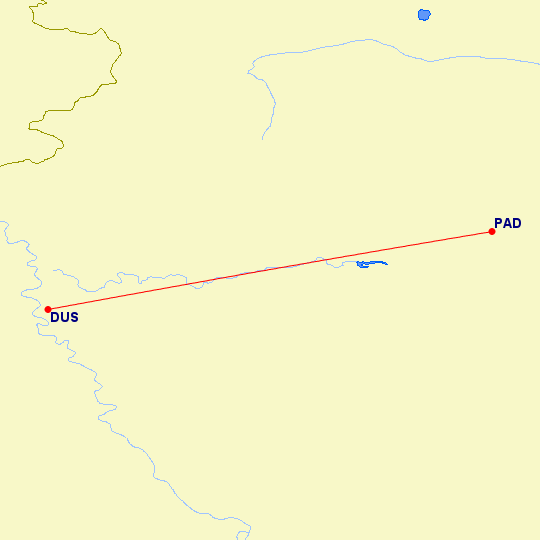 Turbo Commander operated by Flugdienst Carlos de Pilar: 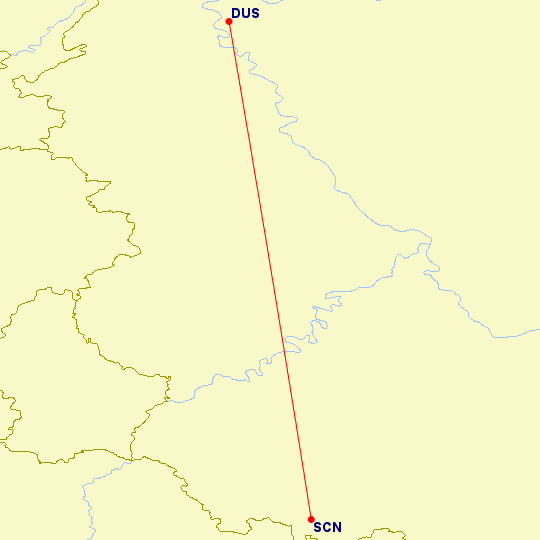 Download LTU International 1998 v3 Flightplans Here Download LTU International 1998 v3 Flightplans Here
|
|
|
|
Post by chasensfo on Nov 29, 2022 2:17:55 GMT -5
//Belair-lle de France 1998 v2 (28NOV22; added 2nd 727 variation now that both liveries are present. Belair-lle de France (1996-2000) IATA: BL ICAO: BLI CALLSIGN: EUROBELAIR Belair-lle de France was a small French charter outfit operating 2 727-200s and an MD-80 on leisure charters, mostly connecting France/Europe to ATH, PMI, and IBZ. The airline was based in Paris Orly(ORY), and initially just flew the 2 727-200s but leased an MD-80 from Air Liberte in 1998. In addition to the charter flying, one of the 727-200s operated on behalf of Air France on Tuesdays and Wednesdays routing through ORY(the charters usually used CDG so these are the only visits to ORY). The Air France flights are straight from the OAG and accurate while the charters are all realistic but representative based on the data I had. The 727s wore 2 different liveries, with one having a dark belly and more colors. These plans are required to complete Air France 1998. The airline shut down in 2000, and the MD-80 was returned to Air Liberte while the 727s were stored in Perpignan(PGF) where they were broken up sometime after 2011, never flying again. All repaints are completed. One of the 727s was painted before on the RAI forums, but I now can't find it or the proper author. I am hosting the paint for now temporarily. AIA 727-200\MD-80 by RAI member ludo66x: drive.google.com/drive/folders/1VMbXiI0Jg1ONUMqfuFBVauzHAziqApv_ AIA 727-200 other livery by unknown RAI member: drive.google.com/drive/u/1/folders/1pm0d7duqFcYsrA5kyzX6AZjoyZi2_1Qs727-200 scheduled flights operating for Air France:  727-200 Charters: 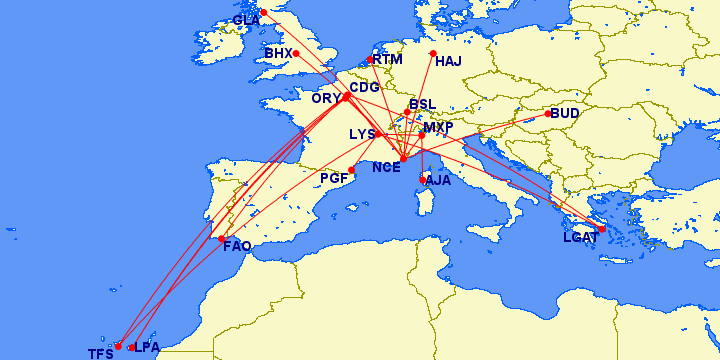 MD-80 Charters:  Download Belair-lle de France v2 1998 Flightplans Here Download Belair-lle de France v2 1998 Flightplans Here |
|
|
|
Post by chasensfo on Nov 29, 2022 2:44:46 GMT -5
//SilkAir 1998 v2 (28NOV22; added Fokker 70 variation for new repaints, re-numbered aircraft list for better AI parking, completed repaint links) SilkAir (1975 - Present) IATA: MI ICAO: SLK CALLSIGN: SILKAIR Silk Air was essentially the domestic division of Singapore Airlines and Singapore's "other" airline, and by 1998 was serving routes too thin for Singapore Airlines' A310s with 737-300s and Fokker 70s. The airline started in 1975 as Tradewinds Charters, leasing aircraft from Singapore Airlines as needed. In 1989, the airline leased 5 MD-87s and changed its name to Tradewinds Airlines, starting scheduled services to leisure destinations in Thailand and Malaysia not served by Singapore Airlines at the time and flying out of Singapore's secondary airport (XSP). By 1992, flights were moved to the primary airport in Singapore(SIN) to better connect passengers to the Singapore Airlines network. The airline became SilkAir and adopted its own livery while a dedicated fleet of 6 737-300s and 2 A310s were painted in the SilkAir livery. Service was expanded as far as India, and SilkAir became the first airline in Asia to hand out portable on-demand video entertainment systems on its aircraft. By 1998, the 737-300s were still the backbone of the fleet and were joined by Fokker 70s for smaller regional routes, but the A310s were gone as well as the routes to India. The first A320 was added in 1998 and is included in these plans. SilkAir, like Singapore Airlines, was one of the safest airlines in Asia, suffering just 1 fatal accident in 1997 that was ruled as pilot suicide by Western investigators and a rudder malfunction by Asian authorities, a controversy that is still alive today. The flight plans resulted in 1 extra 737-300(given the registration of the 1997 accident airplane) and 1 extra Fokker 70(given the Dutch test registration of one of SilkAir's Fokkers). These plans are separated from the rest in case you wish to exclude them. SilkAir retained its original livery and survived the next few decades as a short/medium haul subsidiary of Singapore Airlines while another airline, Scoot, was created for no-frills long haul. Singapore Airlines announced in 1998 that the SilkAir and Scoot brands would be absorbed into Singapore Airlines by 2021 and disappear. The first SilkAir 737MAX8 was painted in full Singapore Airlines colors in 2020. All repaints are completed: FAIB A320: fsxaibureau.com/manufacturing/airbus/airbus-a320/silkair-a320/FAIB 737-300 part of this package(along with the A310s): library.avsim.net/esearch.php?CatID=fs2004aia&DLID=177450AIA Fokker 70 fleet by RetroAI member ludo66x: drive.google.com/drive/folders/1VMbXiI0Jg1ONUMqfuFBVauzHAziqApv_ A320: 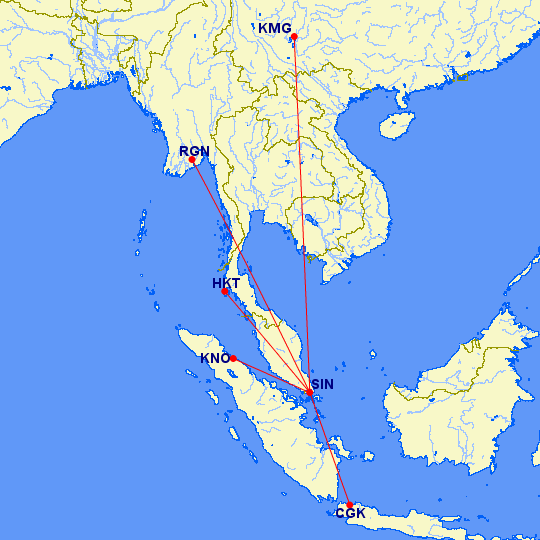 Fokker 70: 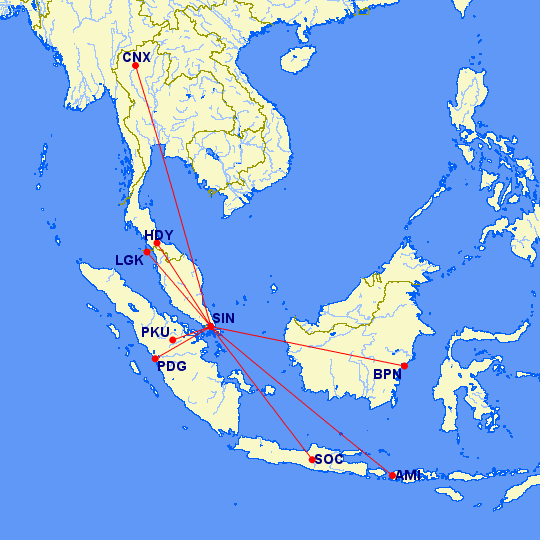 737-300: 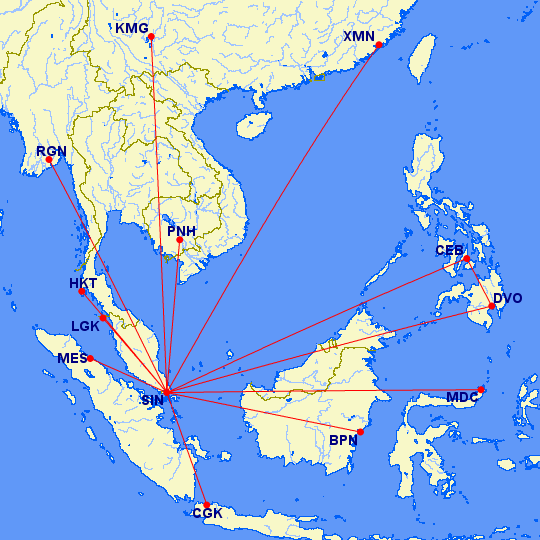 Download SilkAir 1998 v2 Flightplans Here Download SilkAir 1998 v2 Flightplans Here |
|
|
|
Post by chasensfo on Nov 29, 2022 4:14:38 GMT -5
\\Winair 1998 v2 (28NOV22; added new livery variations, changed cruise speeds to AIG standard, repaint links added) Winair (1962 - Present) IATA: WM ICAO: WIA CALLSIGN: WINAIR Not to be confused with the LGB-based airline of the same name in 1998, Winair is an abbreviation for Windward Islands Air, based in St. Maarten(SXM). The airline started with small aircraft like the Piper Aztec and BN-2 Islander but quickly added the DHC-6 to allow for STOL(short takeoff and landing) capability at nearby challenging airports. At one point, Winair did operate aircraft as large as the YS-11, but these flights were short-lived, and Winair has traditionally only flown aircraft with 19 seats or fewer. In 1998, they had a small fleet of 3 DHC-6 Twin Otters, flying from SXM onward to some of the most difficult airports to operate into in the Northern Hemisphere. These guys will be in and out of SXM all day, but stop flying for the most part to most destinations after dark. Winair was and is the only airline to operate into Saba(SAB), the famous cliff-side airport on the island where King Kong was filmed, and also flies frequently into the St. Barths Airport(SBH), which requires a low steep dive over a hill onto a very, very short runway. I had read in the past that FlyTampa said AI aircraft can't use the airport in their SABA scenery, so I am not sure if this has been fixed in updates. Winair has had a very similar route network for decades and is still around today flying most of these same flights, still the only airline allowed to fly to Saba. 3 variations of the 1990s livery for the HTAI DHC-6 by RetroAI member ludo66x may be found here: drive.google.com/drive/folders/1VMbXiI0Jg1ONUMqfuFBVauzHAziqApv_ DHC-6: 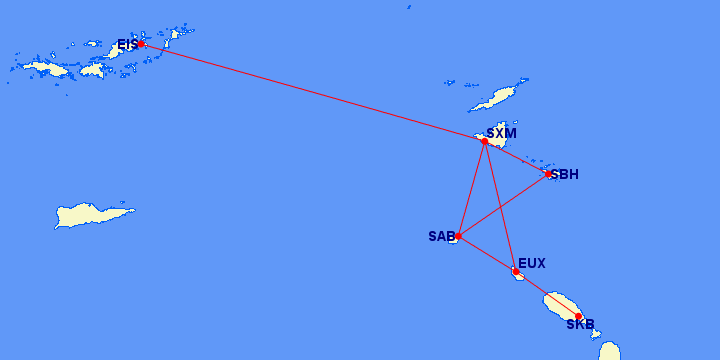 Download Winair 1998 v2 Flightplans Here Download Winair 1998 v2 Flightplans Here |
|
|
|
Post by chasensfo on Nov 29, 2022 4:37:25 GMT -5
\\Olympic Airways 1998 v2 (28NOV22; added new livery variations, added A340 and 1 missing 747-200, 747s now spend long downtime in ATH not other cities, corrected 747-200 being listed as 747-100, correcting missing reg number for a 737-200, re-ordered aircraft for better AI parking, changed cruise speeds to AIG standard) Olympic Airways (1957-2008) IATA: OA ICAO: OAL CALLSIGN: OLYMPIC Olympic Aviation (1971-2003) IATA: ML ICAO: OLY (you may also use "OALX" for parking) CALLSIGN: OLAVIA Olympic Airways was the national airline of Greece for many decades, and one of the largest carriers in Europe, and a household name. Though much like the likes of Braniff, Swissair, and Pan Am, Olympic would suffer a total collapse after the Greek economy crumbled, the airline was flying proudly in 1998. The Olympic network stretched as far as the United States, South Africa, Australia, and Thailand as well as to most major cities in Europe and across a vast domestic network, serving almost all of the commercial airports in Greece at the time. The main hub was the now-closed Athens Hellinikon Airport(ATH), with a secondary hub in Thessaloniki(SKG). Due to the status of Greece as a major holiday destination, several international routes were operated from various secondary Greek cities as well such as Corfu(CFU). Olympic was in expansion mode at the time, with the carrier having retired its 727-200s in 1998 with several 737-800s, A340-300s, and 717-200s due to arrive by the end of the century. However, there were delays, and Olympic would not have its first operation A340 until the summer of 1999, its first 717 until well into the year 2000, and the 737-800s would never arrive. In an effort to fill the capacity gap for the summer season, several 737-300s, 737-400s, and A300B4s were quickly added to the fleet, with most aircraft wearing an all-white livery with Olympic titles and logos. One 737-300 was leased from LOT and operated in a hybrid livery mostly wearing LOT's colors with slight modifications, while the other, acquired from recently failed Western Pacific Airlines of the USA, wore a modified white livery with a colored tail. I assigned the -300s to 2 extra -400s as the OAG did not distinguish these planes. The 737-200 and 737-400 were the backbone of the fleet, flying all across Greece and Europe and with about 20 aircraft. The A300s flew high-density routes to Europe and domestically in Greece, but also operated as far as Bangkok(DMK). 4 747-200s were still active, exclusively operating long-haul flights to other continents, including a ATH-DMK-SYD-MEL route. The recently retired aircraft sat mothballed in ATH with the titles painted over, where some remain at the airport's former site to this day. I have included these retired aircraft which will sit by the Olympic hanger in a future ADEX release for the great FSX scenery for Hellinikon Airport, they sit idle except for a quick touch-and-go flight twice per week to keep them visible(please assign these jets a "XOAL" parking code. In addition to these aircraft, Olympic Aviation was operating a sizable fleet of ATR-42s, ATR-72s, and Do-228s on behalf of Olympic Airways and in their full colors. These aircraft operated a vast domestic network not only from ATH and SKG but from another Rhodes(RHO) hub as well. The ATRs ventured into other European nations, but the Do-228s was purely domestic. Aside from the hybrids, most aircraft wore the 1994-introduced thick blue strip livery, while 1 A300-600R remained in the short-lived colorful 1991-introduced livery with a light blue cheatline and several different vividly colored stripes down the fuselage. The Olympic Aviation fleet all wore white colors with Olympic titles and logos. Olympic Airways began to fall apart in 2005 as the situation of the country grew more desperate. The airline had been slow to modernize, still flying many older aircraft and not widely utilizing electronic ticketing until 2007. Unpaid bills lead to various court battles, and the Greek government announced that Olympic Airways would shut down in 2008 to reorganize as a much smaller regional carrier, re-named Olympic Airlines, which survives today. A shell of the company's former glory. I chose to exclude a VIP Falcon 900 operated by Olympic, but if it is painted, I will go back and do the flight plans. The first A340 arrived in late 1998 and was used on an SYD route, and as I had to "chop up" the 747 flight plans anyway to make the fleet the right size (some 747s were almost always in ATH, even with the small fleet), I assigned one of the transpacific sectors to the first A340 to arrive. The rest of the A340s may be found being flight-tested pre-delivery in Toulouse (TLS) with my Airbus 1998 flight plans. Some 727-200s were operated by a leisure charter subsidiary of Olympic Airways called Macedonian Airlines(not to be confused with MAT), and those flights are included separately. There is a LGAT scenery in progress that I have already made a P3Dv4+ ADE for, but the textures for the scenery are not completed yet as far as I am aware. Several repaints are needed, especially of the 1991 scheme that most planes still wore in 1998 (the company briefly had a 1991 rainbow color livery before reverting to an all-blue livery similar to their long-time black livery from 1994). The following repaints are available: AIA 747-200 1994\TFS A300-600R 1991(plus the rest of the fleet in the mostly-retired 1991 livery): library.avsim.net/search.php?SearchTerm=olympic_fleet_1994.zip&CatID=root&Go=SearchFAIB 747-200 in the old livery (not used anymore by 1996 or so, but here if you want it): brians-retro-ai.com/repaints/olympic-airways-boeing-747-200/FSPX A340-300: library.avsim.net/search.php?SearchTerm=fspxai_a340-300_oly.zip&CatID=root&Go=SearchTFS A340-300: www.flightsim.com/vbfs/fslib.php?do=copyright&fid=117128TFS A300-600R 1994: www.flightsim.com/vbfs/fslib.php?do=copyright&fid=123212FAIB 737-400 1994: library.avsim.net/search.php?SearchTerm=oal-b734-faib.zip&CatID=root&Go=SearchAIA 737-400v2 1994\White: library.avsim.net/search.php?SearchTerm=ai734oal.zip&CatID=root&Go=SearchAIA 737-300v2 White: library.avsim.net/search.php?SearchTerm=aia733v2olympicwhite.zip&CatID=root&Go=SearchOSP ATR-72: library.avsim.net/search.php?SearchTerm=texture_256815.zip&CatID=root&Go=SearchOSP ATR-42: library.avsim.net/search.php?SearchTerm=oly_atr42.zip&CatID=root&Go=SearchFMAI Do228 Fleet by RetroAI member ludo66x: drive.google.com/drive/folders/1VMbXiI0Jg1ONUMqfuFBVauzHAziqApv_ AIA 727-200 retired: drive.google.com/drive/folders/1M6iMNsSUqZEpdHaTILyZ28FLd7s7_p5j?usp=sharingFlightplans by Vireak Ball and myself. 747-200B: 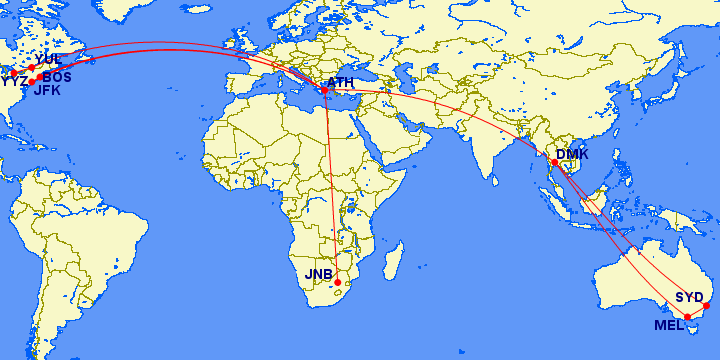 A340-300: 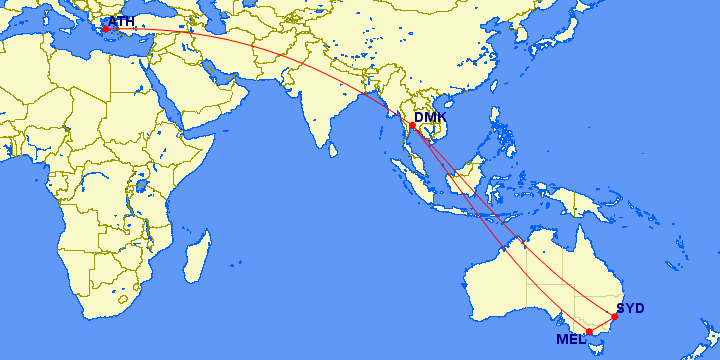 A300B\A300-600R: 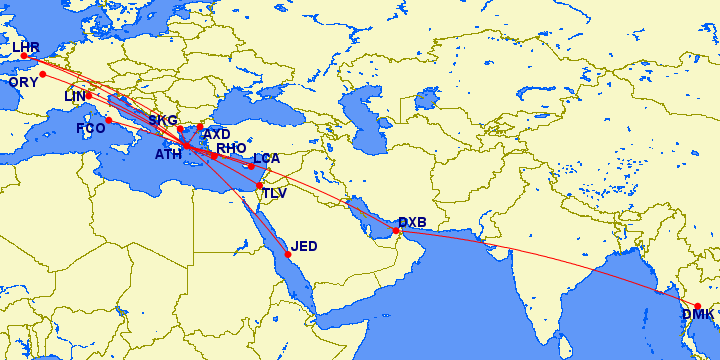 737-300\400: 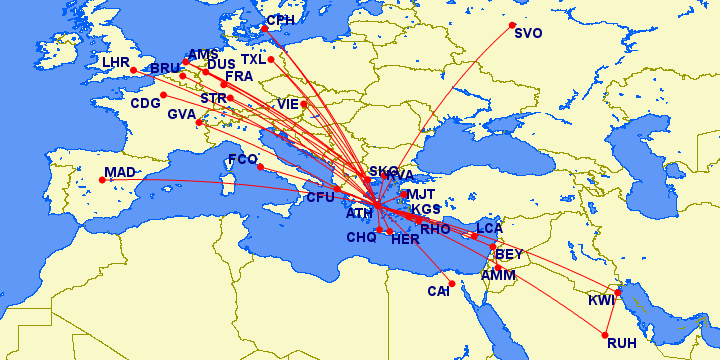 737-200: 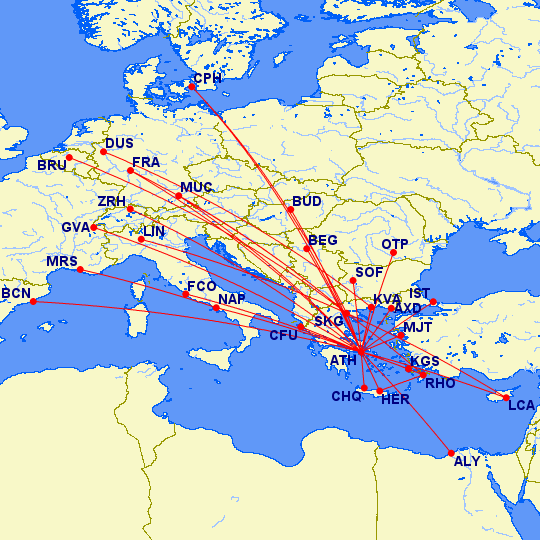 ATR-42-320 operated by Olympic Aviation: 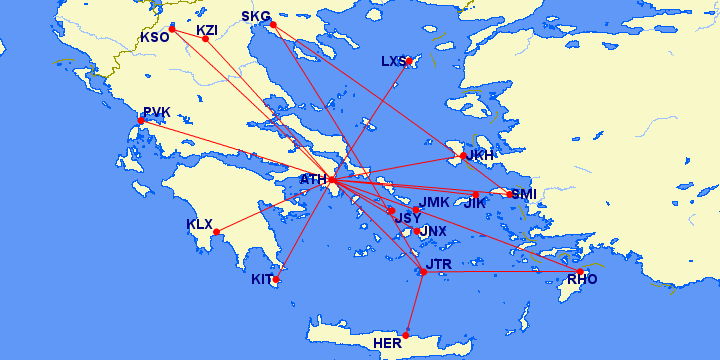 ATR-72-202 operated by Olympic Aviation: 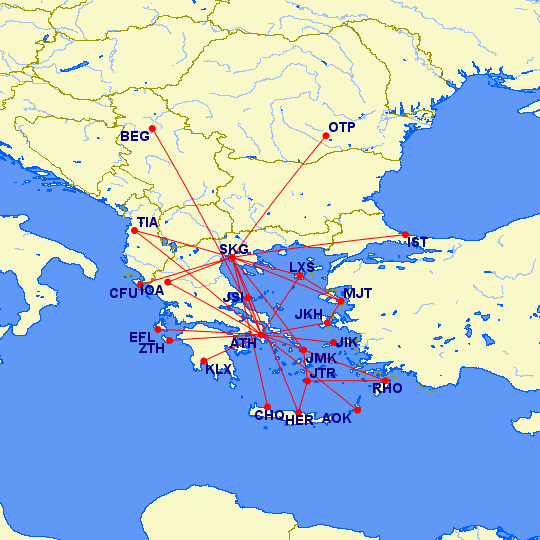 Do-228-200 operated by Olympic Aviation: 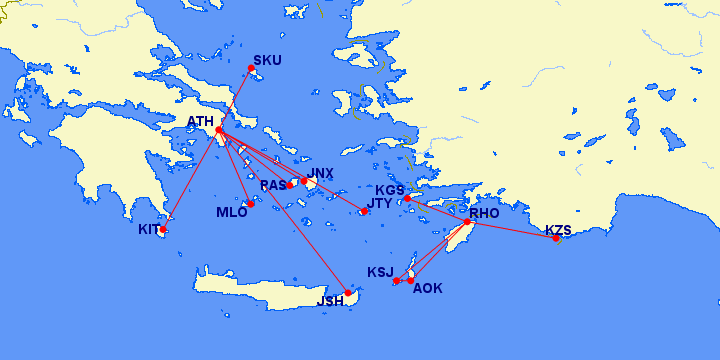 Download Olympic Airways 1998 v2 Flightplans Here Download Olympic Airways 1998 v2 Flightplans Here |
|
|
|
Post by chasensfo on Nov 29, 2022 5:00:58 GMT -5
\\Air Saint Martin 1998 v2 (28NOV22; added variations for new repaints, added 2nd Do228, adjusted cruise speeds to AIG standard) Air Saint Martin (1969-2000) IATA: S6 ICAO: ASM CALLSIGN: AIR SAINT MARTIN Air St. Martin operated out of SFG(known as Saint Martin\Grand Case airport), which was on the French side of the island as opposed to St. Maarten (SXM) on the Dutch side. The airline flew a mix of charters and scheduled services. The only scheduled route was SFG-PTP, but I have created charter flights for the rest of the Caravan fleet based on web data from the period listing their charter destinations and photo evidence. In 1998, the airline was flying a Do-228 and several Cessna 208 Caravans in a white livery with Air Saint Martin titles and French-registered aircraft. In 2000, Air Saint Martin was merged with Air Guadeloupe, Air Martinique, and Air Saint Barthélémy (all French-registered airlines in the Netherlands Antilles) to form Air Caraibes, which is a large international airline today and is the sister airline of French Bee, owned by the same holding company. Fleet repaints for the FMAI Do228 and HTAI Cessna 208B by RetroAI member ludo66x may be found here: drive.google.com/drive/folders/1VMbXiI0Jg1ONUMqfuFBVauzHAziqApv_ Cessna 208B and Do228 scheduled flights: 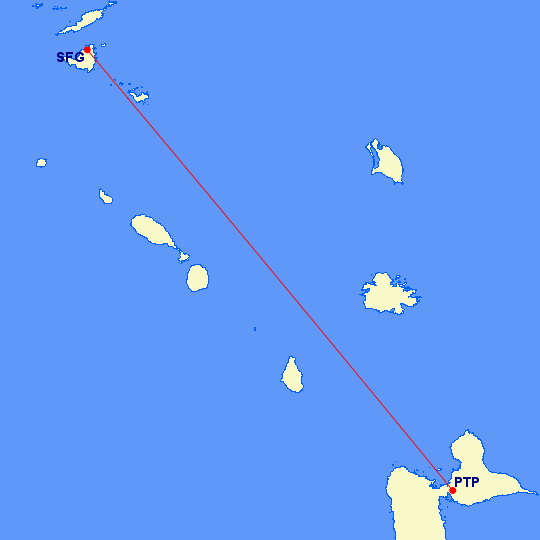 Cessna 208B charter flights: 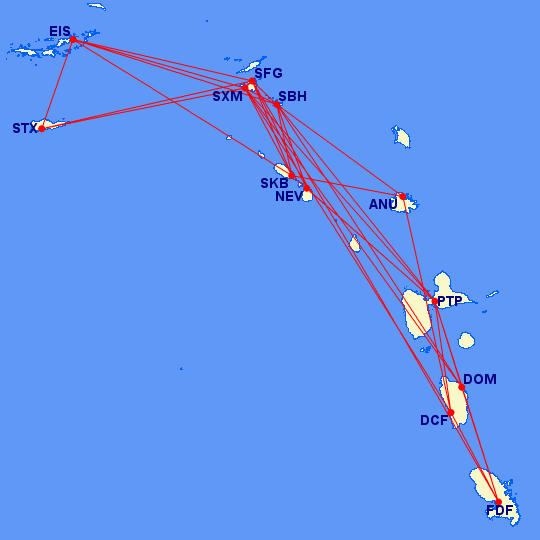 Download Air Saint Martin 1998 v2 Flightplans Here Download Air Saint Martin 1998 v2 Flightplans Here |
|
|
|
Post by chasensfo on Nov 29, 2022 6:44:59 GMT -5
//Air Guadeloupe 1998 v2 (28NOV22; added variations for new paints, added 2 missing ATR42s by splitting up flight plans, made livery assignments more realistic after discovering some more old colors aircraft in 1998, renumbered aircraft order for better AI parking) Air Guadeloupe (1970 - Present) IATA: TX ICAO: AGU CALLSIGN: AIR GUADELOUPE Air Guadeloupe was the predecessor of Air Caraibes, based in Point-a-Pitre(PTP) in French Guadeloupe in the French West Indies. The airline was founded in 1969 by French interests and began flying in 1970 with all aircraft French-registered, first operating a lone DHC-6 Twin Otter. They flew across the Eastern Caribbean with a focus city in Martinique(FDF). Another Twin Otter and several Do228-200s were added to the fleet, and the company expanded with charters as well as a robust scheduled network across the region. Caravan I props allowed for expansion to some smaller islands previously unable to be served by the larger 19-seat aircraft, and focus cities developed in St. Maarten(SXM), Grand Case(SFG), and St. Barths(SBH). The airline added ATRs in the 1990s, first obtaining 1 example each of the ATR-42-300\500 and the ATR-72-200\210. These aircraft were used for expansion to several international destinations including San Juan(SJU), Haiti(PAP), French Guiana(CAY), and The Dominican Republic(SDQ). A new, more simple livery with a white fuselage, yellow tail, and red titles was adopted in 1996 and by 1998, all aircraft except for the ATR-42-300 wore this new livery. The carrier had dropped the Cessnas by 1998 but had a relatively large fleet of Do228s along with the ATRs and the pair of DHC-6s. Air Guadeloupe was one of many commuter airlines signed to franchise deals with Air France in 1998, but flights operated by an Air France-dedicated ATR-72 are not included in these flight plans and are found in the Air France flight plans. In 1999, the airline leased a 737-200 for a few months from Air Atlanta Icelandic in a joint operation with neighboring Air Martinique, with the aircraft painted in Air Guadeloupe colors but with Air Martinique titles on the starboard side. The 737 was used most of the week for flights connecting PTP and FDF with Miami(MIA), but on weekends the flight operated later in the day and routed via SJU. The airline merged with Air Martinique in 2000 and became Air Caribes. Jets like the Embraer 145, 170, and 190 joined the fleet along with long-haul aircraft like the A330 and A350 allowing for expansion to Paris(ORY). Today, the company also owns the French long-haul subsidiary French Bee, based in ORY. I have included the 1999 737-200 operation. Most aircraft were in the 1996 introduced livery which was quickly painted across the fleet, but the 1980s colors remained on some ATR42s and Do228s. All ATR72s and the DHC-6s had the new livery by 1998. As far as I know, some repaints are still needed, including the 737-200. The following repaints are available: OSP ATR72\ATR42, FMAI Do228, HTAI DHC-6 1996 livery by RetroAI member ludo66x: drive.google.com/drive/folders/1VMbXiI0Jg1ONUMqfuFBVauzHAziqApv_ OSP ATR42, FMAI Do228 1986 livery by RetroAI member Alex\ funk: app.box.com/v/7funk/file/12639405198737-200:  ATR-72: 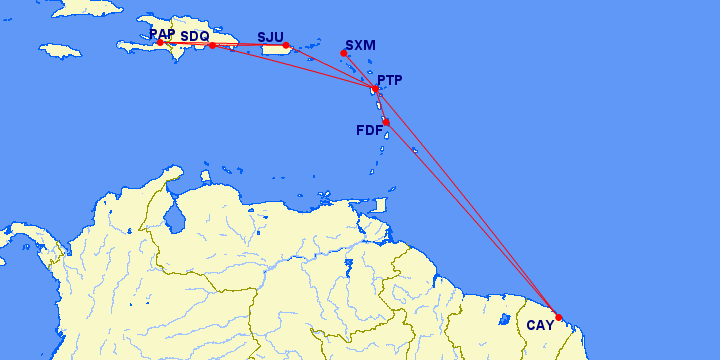 ATR-42:  ATR-42 Charters: 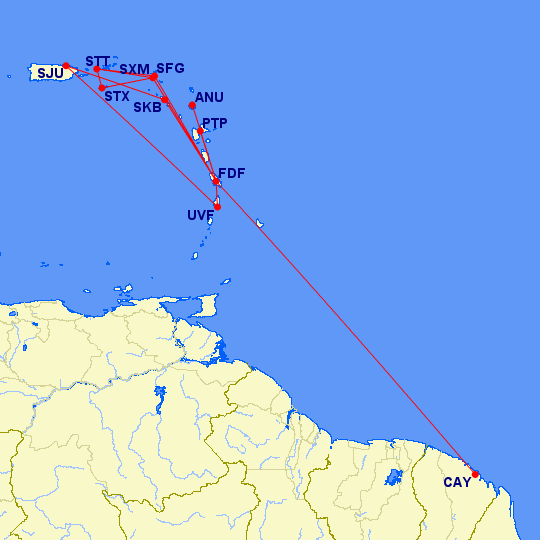 Do228: 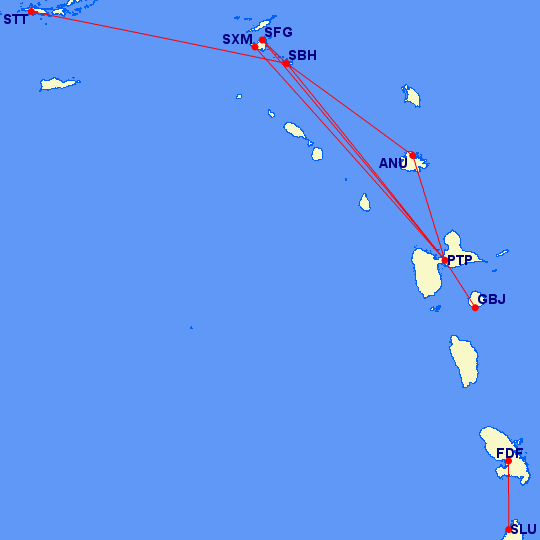 DHC-6:  Download Air Guadeloupe 1998 v2 Flightplans Here Download Air Guadeloupe 1998 v2 Flightplans Here |
|
|
|
Post by chasensfo on Dec 6, 2022 12:23:10 GMT -5
As the rest of US Airways (mainline, express, and shuttle) is being done for 1999, and as Metrojet absolutely exploded in size between 1998 and 1999, I am releasing Metrojet 1999 to replace Metrojet 1998 in its infancy by James Hamelers (https://library.avsim.net/search.php?SearchTerm=us_airways_metrojet_su98.zip&CatID=root&Go=Search). Please delete the 1998 plans if you are using them. \\US Airways Metrojet 1999 US Airways Metrojet (1998-2001) IATA: US ICAO: USA (also use "USM" for AI parking) CALLSIGN: USAIR US Airways Metrojet, otherwise simply known as "Metrojet", was the low-cost no-frills division of US Airways based in Baltimore(BWI), created to combat the expansion of popular low-cost carrier Southwest Airlines into US Airways' BWI hub. The company was started in 1998 with a quickly growing fleet of 737-200s they were retired from mainline use and painted in a bold red and tan livery with a US Airways tail design, though several aircraft added prior to 2000 were operated in hybrid colors with the 1989-introduced bare-metal livery. Unlike the US Airways Shuttle operation which had its own operating certificate, codes, and callsign, Metrojet was fully operated by mainline US Airways, though the operation used its own gates or shared with US Airways Shuttle in the cases of Boston (BOS) and IAD. This concept was nothing new, Continental had previously had a short-lived "Continental LITE" product operating by the same logic while United and Delta had ongoing LCC operations called "Shuttle by United" and "Delta Express" respectively. Initially, 5 737-200s were used on routes where US Airways decided to combat Southwest's presence with high-frequency service, but the route network quickly expanded to include point-to-point service between several destinations and Florida, in competition with Delta Express. Soon after in 1999, the airline would expand to add a Washington DC (IAD) focus city and would grow further into the 2000s adding routes as far West as Tucson(TUS) while ultimately adding almost 50 aircraft to the fleet and 27 destinations prior to the 9\11 attacks. Routes by the end of the century mostly connected BWI and IAD to points in Florida and the Northeast and Southeast United States, as well as being used to attack Southwest's Chicago Midway (MDW) and St. Louis (STL) hubs with high-frequency low-fare service from both IAD and BWI. Only a few of the hybrid livery 737s had been repainted into the red top colors before the post-9\11 travel slump and resulting economic hardship forced US Airways to terminate Metrojet in late 2001, and ultimately to drop the BWI hub, surrendering its market share to Southwest Airlines. The MetroJet fleet was retired to the California desert where the airframes were quickly resold or scrapped. I have modified these plans properly for Michael Person's excellent repaints to take advantage of the variations. To ensure proper parking, please use "atc_parking_codes=USM,USA" with these textures. Micheal Pearson's FAIB 737-200 USAir and Metrojet fleet may be found here: drive.google.com/u/0/uc?id=1Y94G4cNcE2em32hXSbzIsRoBTfs5Jnpm&export=downloadFlightplans by RetroAI memeber cmd320. 737-200:  Download US Airways Metrojet 1999 Flightplans Here Download US Airways Metrojet 1999 Flightplans Here |
|
|
|
Post by chasensfo on Dec 15, 2022 9:26:06 GMT -5
//Air Afrique 1998 v3 (15DEC22; added several missing aircraft with a significantly larger fleet, added many variations for Michael Pearson's repaints, re-ordered aircraft for better parking, assigned AIG standard cruise speeds) Air Afrique (1961-2002) IATA: RK ICAO: RKA CALLSIGN: AIR AFRIC Air Afrique Cargo operated by Air Sofia (1996-2000) IATA: RK ICAO: RKAC CALLSIGN: AIR SOFIA Air Afrique Cargo operated by TAROM (1994-2004) IATA: RK ICAO: RKAC CALLSIGN: TAROM Air Afrique was founded as a multi-national carrier representing several countries in West Africa including the countries of Ivory Coast, Chad, the Republic of Congo, Senegal, Niger, Burkina Faso, the Central African Republic, Togo, and several other smaller nations(some of these countries joined in the venture over time and not initially). As such, the airline had a very bizarre route network as it stopped in many of the hubs along the way, sometimes flying routes with as many as 7 or 8 stops between 2 points with the same aircraft and flight number! The airline had a wide-ranging fleet history operating many types from early props like the DC-4 to the Boeing 747, of which one was leased and operated in full Aer Lingus colors. The carrier operated DC-8s and 767s on most of its long haul services into the 1990s while Boeing 737-200s and -300s flew the West African routes. Air Afrique also code-shared with other West African carriers, including Air Corte de Ivorie who operated Fokker 100s on behalf of Air Afrique in the 1990s. By 1998, the fleet narrowbody fleet consisted of a pair of 737-300s and a 737-200 leased from Pacific Airlines of Vietnam in a triple hybrid livery between that carrier, Air Afrique, and TEA Cyprus. The 737s did most of their flying around West Africa and down to JNB as well. 4 A310-300s and several A300B4s and A300-600Rs were used for long-haul flights with various African stops en route and many intra-European routes as well. The A300s were seemingly based mostly in CDG, with most sectors ending up back in Paris eventually. MRS and BOD were also used to connect points in Africa and FCO and LIS while crossing the Atlantic to JFK several days per week. On top of long-haul flying, the extensive African network often had A310s and A300s hopping short distances on 15 to 20-minute flights across West Africa. The A310s do occasionally fly long haul but mostly serve West Africa. In addition to the scheduled flying, cargo flights were being performed under the Air Afrique banner by an Air Sofia An-12 and an Analinda Air 707-300C. I have provided representative flights for these aircraft based on photo data and the hubs of Air Afrique. A DC-10-30ER was also in the fleet at the time, but leased out to AOM who was using it on services for Cubana at the time, so it is excluded from these flight plans. As the rotations on these multi-stop routes sometimes took many days to complete, I had to construct these flight plans in a very time-consuming fashion with much research to account for all flights as many tech-stops where Air Afrique didn't have traffic rights were unlisted. Still, the result is a very accurate representation of this African giant in its prime. Sadly, the terrorist attacks in the USA on 9/11 caused a global aviation crisis and Air Afrique was not well positioned to survive the next few years of stringent and costly new procedures and limited travel demand, and the airline failed in 2002 after 41 years of service. During 1998, Air Afrique was undergoing major fleet transitions. It's lone 737-200 had run off the runway in Douala (DLA) in 1997 and a Cyprus-registered triple hybrid 737-200 was operating for it. The carrier's first 2 African-registered 737-300s arrived as well, with 3 other aircraft being operated by TEA Switzerland with their Swiss registration and small TEA stickers. 2 A300-600Rs were leased at the time in interesting hybrid liveries, while an A310-300 was operated in an all-white scheme after being acquired from Canada 3000 in a deal involving Royal Airlines. The A300-600 fleet and 737-300 fleet have extremely low utilization times operating the full schedule. As there were 2 briefly leased A300-600Rs and the 737-300s were beginning to return to Switzerland, it would appear to be a likely combination of preparing new aircraft for service, preparing leased aircraft to exit service and probable maintenance which was carried out in CDG for larger issues and inspections. So to realistically create the fleet, some of the A300 and A310 fleet will be down in CDG for part of the week with the majority of other seldomly flown aircraft sitting idle in Air Afrique's main hubs. African airports, even the hub cities with service by Sabena and others, were often dead for hours at a time between commercial airline flights These plans will help add some of the largely static airliners that made up much of what was seen at these airports, just sitting around for days or weeks here and there. This was close to the peak for Air Afrique. All repaints are completed, though not all are P3D native. Micheal Person did repaints of most of the fleet while the An-12 and 707 are available FS9 native (as are most of the rest of the aircraft): TFS A300B\A300-600R\A310,FAIB 737-200\300 Fleet: mpai4fs.com/category/repaints/airlines/air-afrique/FAIB 737-200 Pacific Airlines\TEA Cyprus Hyrid: On Avsim as library.avsim.net/search.php?SearchTerm=faib_737-200_tek.zip&CatID=root&Go=SearchAIA 737-300v2 FS9 Native: library.avsim.net/search.php?SearchTerm=texture_255533.zip&CatID=root&Go=SearchSKJ An-12 FS9 Native: www.flightsim.com/vbfs/fslib.php?do=copyright&fid=122948TFS A310-300 FS9 Native by 747sp: www.box.com/s/vl4ynvge08lbmh4xmljx?fbclid=IwAR3nGaoa7ix441v7LoFd8Gl0r5N0mTkN3EKarHBmK-L95Rk50bb15OxUTbETFS A300B2 FS9 Native by Jason King(2 versions): drive.google.com/drive/folders/1GJGLUdW3fUeB7RPGwYPvtSys9D9tNU72?usp=sharingTFS A300-600R FS9 Native by Jason King(2 versions): drive.google.com/drive/folders/1MpXNcyVWLWGqwjH4oqA7UFdxht20th2e?usp=sharingNAAI 707-300C FS9 Native by Christian Gold: drive.google.com/file/d/1knDqvUeEj6N9AQJqNjrTf1M4FLfJSVrv/view?usp=sharing737-200\300 scheduled flights: 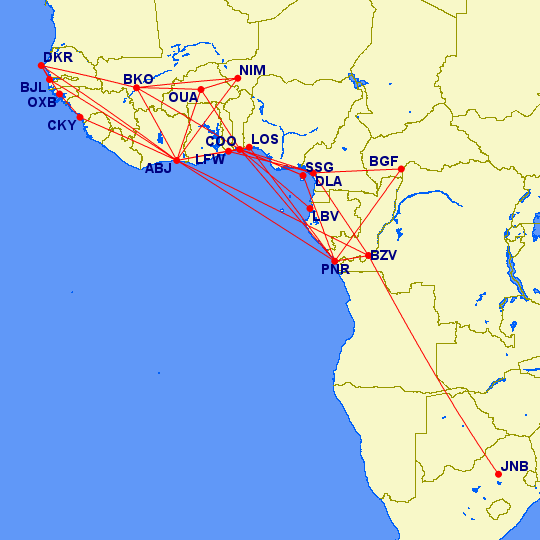 A310\A300B4-200\A300-600R scheduled flights: 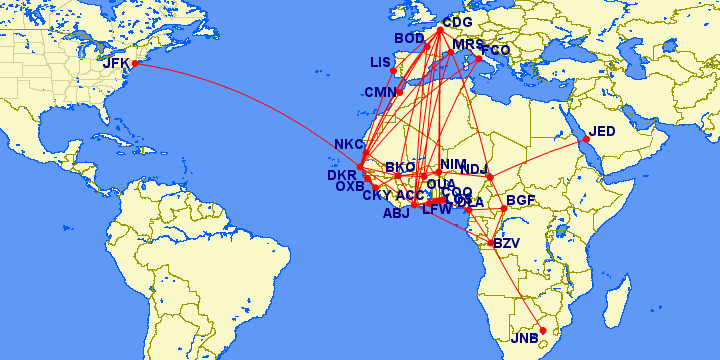 An-12B operated by Air Sofia representative cargo charters: 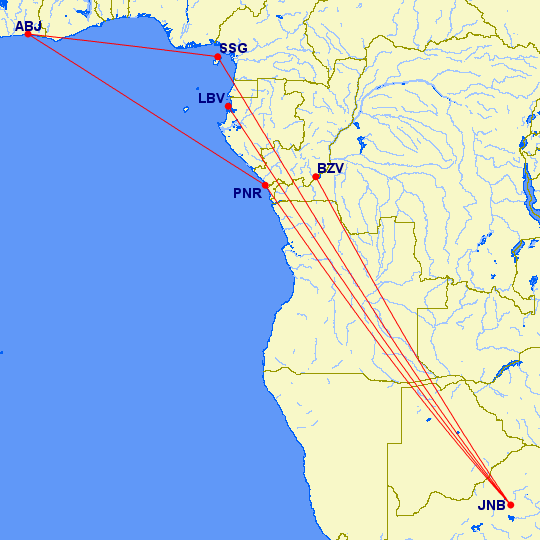 707-300C operated by TAROM representative cargo charters: 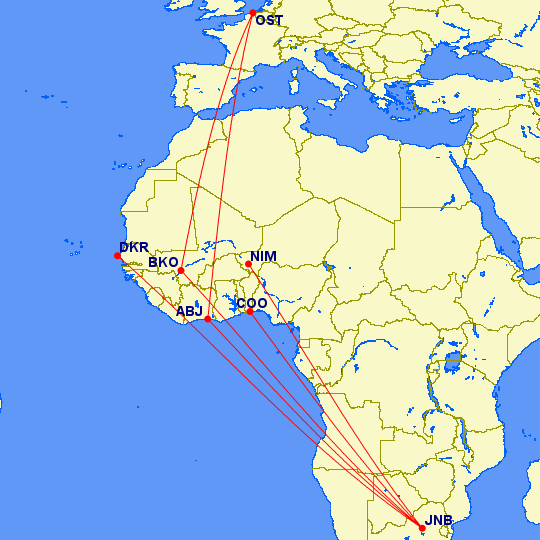 Download Air Afrique 1998 v3 Flightplans Here Download Air Afrique 1998 v3 Flightplans Here |
|
|
|
Post by chasensfo on Dec 15, 2022 9:38:51 GMT -5
//Kenya Airways 1998 v2 (15DEC22; Added a few variations for Micheal Pearson's fleet repaints, removed inaccurate new livery 737-200, re-ordered aircraft for better AI parking, changed to AIG standard cruise speeds) Kenya Airways (1977 - Present) IATA: KQ ICAO: KQA CALLSIGN: KENYA Kenya Airways operated by Eagle Aviation (1995-1999) IATA: Y4 ICAO: EQA (use KQAX as well for parking) CALLSIGN: MAGNUM Kenya Airways is the national airline of the African nation of Kenya and has long been an international presence across Europe. The airline had leased 2 707s early on and was serving FRA, ATH, LHR, and FRA in the first few months of operation. Various other aircraft were operated over the years, including DC-8s well into the 1990s, for long-haul fights and about 1 dozen types of aircraft for domestic routes. By 1998, Kenya Airways had scaled back a bit on the long haul flying with the retirement of the DC-8s earlier in the 1990s, dropping a few cities like Paris(ORY). However, a fleet of 4 A310-300s was still doing a bit of long haul as well as some high-density intra-Africa flying. 2 737-200s and 4 737-300s did most of the African flights, replacing the recently retired DC-9s, and had a network stretching out as far as Cairo(CAI)! Mainline Kenya Airways had a lone Fokker 50 in the fleet(which flew twice weekly). This Fokker was supplemented by Eagle Aviation's ATR-42s, which had been operated on scheduled flights on behalf of Kenya Airways since 1995, while the rest of the Eagle Aviation fleet operated independently in competition against Kenya Airways. Only the ATR operating for Kenya Airways, which flew in that role for 4 years from 1995 to 1999, is included in these flight plans. Kenya Airways was amid a livery change from the white tail livery to the late 1990s red tail livery reasonably similar to the one used today. A 737-200, the Fokker 50, and an A310 still wore the old whitetail livery in 1998, and the rest of the fleet had been painted. Sadly, the A310 named "Harambee Star" would be lost in early 2000 in a tragic accident on departure from Lagos(LOS), which was the airline's first fatal accident, and I dedicate these plans in the memory of those souls lost. While there was another accident with a 737-800 years later, Kenya Airways is still regarded as one of Africa's safest airlines in modern times, and is a member of the SkyTeam Alliance alive and well today with modern equipment. As Kenya Airways only had 1 737-200 and 1 737-300 in the fleet at the time, there is no 737-200 in the new livery or 737-300 in the old livery used in these plans. The A310 fleet now has variations to cover most of the fleet so that in NBO you have variety. These plans make it very apparent how fast Kenya Airways exploded into a major carrier in the 2000s and 2010s. The Eagle Aviation ATR is still needed, the rest of the repaints are available: TFS A310-300, FAIB 737-200\300 Fleets: mpai4fs.com/category/repaints/airlines/kenya-airways/AIA 737-300 FS9 Native: library.avsim.net/search.php?SearchTerm=aia_737_300_kqa.zip&CatID=root&Go=SearchTFS A310-300 Old Colors and NAAI Fokker 50 FS9 Native by RAI member 747sp: app.box.com/s/7x8uzp8wqw4zuf2vtwtr737-200\300: 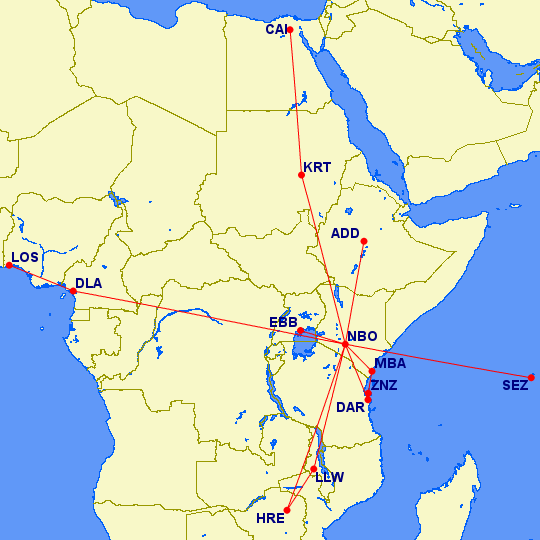 A310-300 GE:  ATR-42-300 operated by Eagle Aviation: 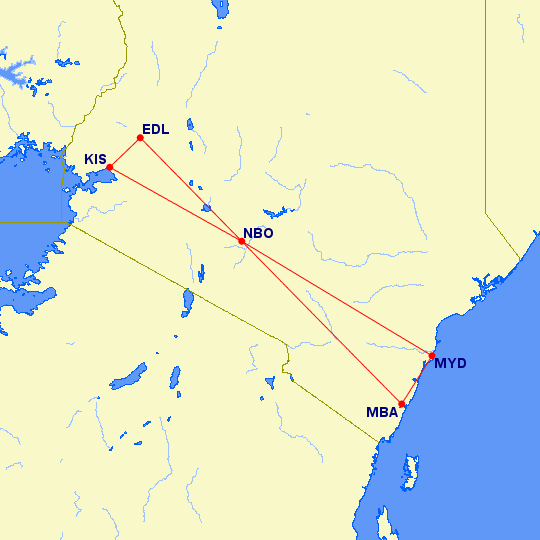 Fokker 50: 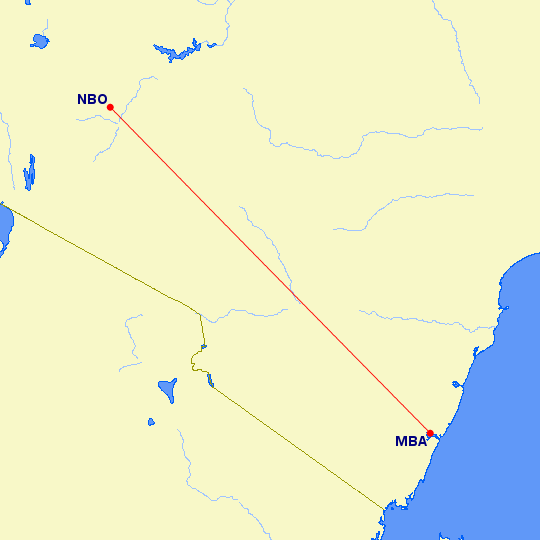 Download Kenya Airways 1998 v2 Flightplans Here Download Kenya Airways 1998 v2 Flightplans Here |
|
|
|
Post by chasensfo on Dec 16, 2022 2:19:36 GMT -5
\\Air Madagascar 1998 (incomplete) Air Madagascar (1961 - Present) IATA: MD ICAO: MDG CALLSIGN: AIR MADAGASCAR Air Madagascar is the flag carrier of Madagascar, the African island nation located off the Southeastern coast of the mainland, and is based in Antananarivo (TNR). In 1998, the carrier was using a 747-200B Combi and a pair of 767-300ERs for long-haul flights to Europe, while regional flying was done by a pair of 737-200s, a 737-300, and an ex-Air Mauritrius ATR42 on a short-term lease in a hybrid livery. The 767-200s and HS-748s were retired. A fleet of DHC-6 Twin Otters was also being operated all across the island utilizing some airports that were little more than dirt or grass strip in the wilderness. Some of those airports may not be in the sim and may have closed since. One of the 767-300s was only in the fleet between 1998 and 1999. Fleet utilization was rather low, as was common with African carriers at the time. The 747 only had 2 scheduled weekly flights, both between TNR and Rome (FCO), with the flight continuing to Paris (CDG) once per week. The 747 was actually operationally based in Paris, and would terminate there on Mondays to then operate for TAAG Angola on until Saturday with idle time spent in CDG otherwise. These flights were to cover for TAAG's 747-300 which had to be taken out of service in the schedule used for these flightplans. I have created these flights using the real suspended TAAG flights (operated in the July 1998 OAG but not the October 1998 OAG). Upon arriving in CDG on Monday, the aircraft has a long sit then ferries to LIS to operate LIS-LAD-GIG-LAD-LIS-CDG as revenue TAAG flights arriving back on Saturday with a quick turnaround back to TNR. The ferry flight was required as TAAG routed their CDG services LAD-LIS-CDG-LAD. The 767-300s also only performed a few flights each to both FCO and nonstop to CDG as well, with the FCO flight continuing on to Munich (MUC) twice per week. Both the 737s sat around but I found no evidence of charters, with the 737-200s only flying 1 or 2 weekly routes each. After the ATR was returned, Air Madagascar did not operate ATRs mainline again until acquiring TAM Madagascar's ATRs in the early 2000s. These incomplete flight plans include all aircraft except for the DHC-6s, which I have no timeline on completing myself as they have a large and complex schedule mostly utilizing airports with little information and that are not recognized by the sim. All repaints are completed except for the ATR: FAIB 747-200BM: library.avsim.net/search.php?SearchTerm=faib_747-200_mdg.zip&CatID=root&Go=SearchFAIB 767-300 Fleet: library.avsim.net/search.php?SearchTerm=faib_767-300_mdg.zip&CatID=root&Go=SearchFSPX 767-300 + FAIB 737-300 by Nils Gosselin: drive.google.com/drive/folders/1quVvCRN9Witjsdox18VhC2vuBH5wd4SZFAIB 737-200 Fleet: library.avsim.net/search.php?SearchTerm=faib_737-200_mdg.zip&CatID=root&Go=SearchFAIB 737-200 update: library.avsim.net/search.php?SearchTerm=faib_737-200_mdg_fix.zip&CatID=root&Go=SearchCPAI HS748 (retired but you may use it in place of the ATR if you wish): library.avsim.net/search.php?SearchTerm=cpai_hs748_mdg.zip&CatID=root&Go=Search747-200BM: 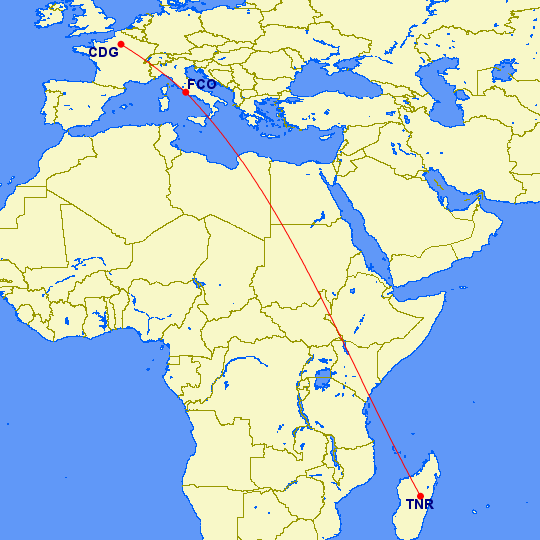 747-200BM operating for TAAG Angola: 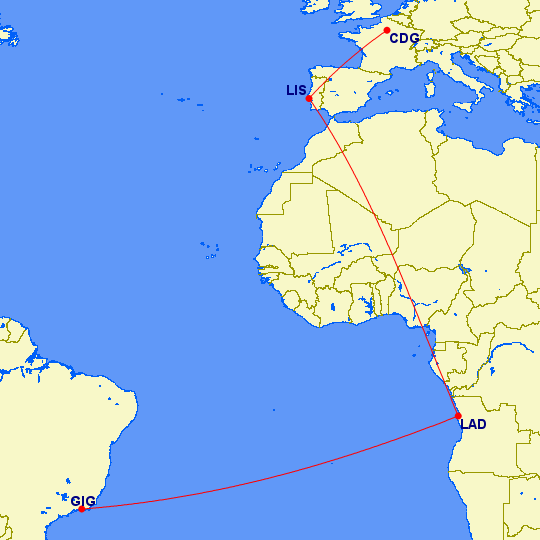 767-300ER: 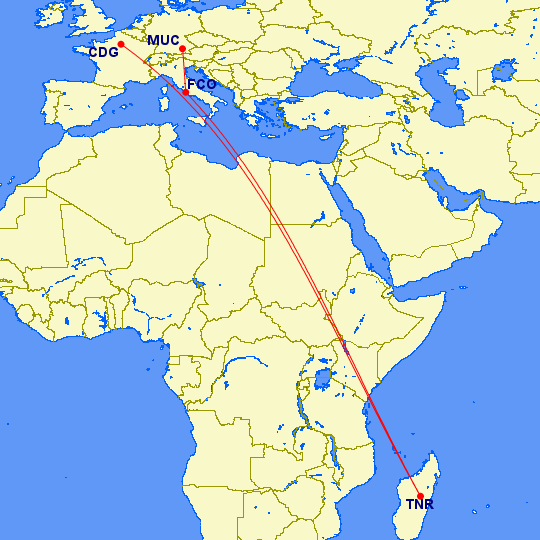 737-300:  737-200:  ATR42-300: 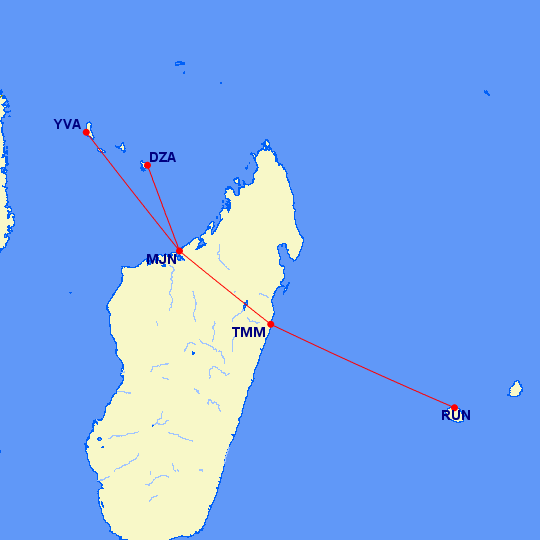 Download Air Madagascar 1998 Incomplete Flightplans Here Download Air Madagascar 1998 Incomplete Flightplans Here |
|
|
|
Post by chasensfo on Dec 16, 2022 2:25:40 GMT -5
\\Air Austral 1998 v2 (15DEC22; added livery variations for P3D native fleet repaints by Nils Gosselin, changed cruise speeds to AIG standard) Air Austral (1977 - Present) IATA: UU ICAO: REU CALLSIGN: REUNION Air Austral is the national airline of the French-controlled island of Reunion(RUN) in the Indian Ocean near Africa. The airline was first founded with an HS748 as Reunion Air Service, island hopping in the region. In 1986, the airline became Air Reunion but did not begin to venture into the African continent until receiving its first 737-300 in 4 years later in 1990 and again changing its name, this time to Air Austral. An ATR72 was briefly operated but disposed of by the late 1990s. By 1998, the airline had still yet to venture into long-haul flying and was operating 2 737-300s(one of them a "quick change" combi variant) and a 737-500 to neighboring islands and venturing a bit into Western and Southern Africa. As The Comoros and Mayotte didn't have flag carriers, Air Austral and Air Madagascar connected destinations to these islands beyond RUN. Note that the YVA airport of The Comoros has since closed and the HAH airport further north is used now. The aircraft are hard-working, but from time to time, all 3 sit together in RUN. In the coming years, the airline would add a 767 and venture into long-haul flying, adding other types like the A330 afterward. Today, the airline flies modern aircraft such as the 777-300ERs and Boeing 787s across the globe while A220s are used for regional flights across Africa. FAIB 737-300\300QC + 737-500 Fleet Repaints by Nils Gosselin: drive.google.com/drive/folders/1q1TYjTT73mPZ0mzobkqlvqZcv1yxtRpxFAIB 737-300 + 737-500 by RetroAI member Alex\Funk (FS9 Native): app.box.com/v/7funk/folder/8779151413737-300\737-300QC:  737-500:  Download Air Austral 1998 v2 Flightplans Here Download Air Austral 1998 v2 Flightplans Here |
|
|
|
Post by chasensfo on Dec 16, 2022 2:35:00 GMT -5
\\Skymark Airlines 1998 v3 (15DEC22; added livery variations by Michael Pearson, changed cruise speeds to AIG standard) Skymark Airlines (1998 - Present) IATA: BC ICAO: SKY CALLSIGN: SKYMARK Skymark Airlines is a Japanese low-cost carrier(LCC) that was founded in 1996 and began flying in 1998. Initially, the airline started with 2 767-300s flying between Tokyo-Haneda(HND) and Fukuoka(FUK) 4 times daily. This initial route only utilized 1 767, and the other was used extensively for training new crew members in Shimojishima(RORS) until later in 1999 when a new Osaka-Itami(ITM) to FUK route was launched, followed by another route from ITM to Chitose(CTS). Both of Skymark's 767-300s were flown in special liveries, with one advertising Direct TV and one advertising Microsoft. By 2000, the airline ran into trouble early on and both routes from ITM were suspended. Initially, ANA was doing the ground handling and maintenance for Skymark, but Skymark elected to end the contract with ANA and handle these functions themselves. The airline would find more funding and expand both domestically and with international charters. Skymark is still flying in Japan today, and has recently added Airbus A330s to the fleet and was at one point due to receive Airbus A380s, but that order was canceled in a controversial move that was contested by Airbus. The 767 not operating the regular flights spends its time in RORS where it does 2 daily touch-and-go landing sessions, simulating training. In 1999, the 1st 767-300 got a new livery, and Michael Pearson painted it in both the 1998 and 1999 colors so you may use whichever paint you see fit. The FAIB 767-300 fleet by Michael Pearson may be downloaded here: 767-300 Scheduled Flights:  767-300 Training Flights: 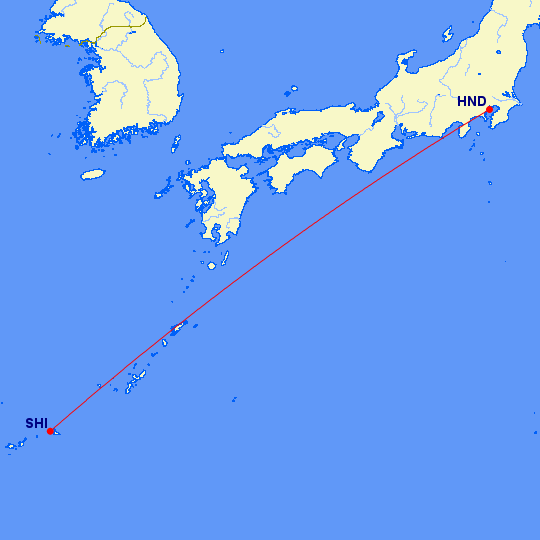 Skymark 1998 Version 3 flightplans here Skymark 1998 Version 3 flightplans here |
|
|
|
Post by chasensfo on Dec 16, 2022 5:43:18 GMT -5
\\Yemenia 1998 v2 (16DEC22; Added a few missing aircraft, many new livery variations for Michael Pearson's fleet repaints, re-ordered aircraft for better AI parking, adjusted cruise speeds to AIG standard) Yemenia (1940 - Present) IATA: YI ICAO: IYE CALLSIGN: YEMENI Yemenia is one of the oldest airlines in the Middle East, and the national airline of Yemen, which, much like their home country, has had a very troubled history in modern times. Yemen has long been the least stable and most economically disadvantaged country in the Persian Gulf. As a result of these issues, Yemenia has been unstable in its operational capabilities over various periods, having been banned for safety reasons from operating European routes since 2008. Initially, the airline did well, and quickly grew from props to jets, to long-range flights to Europe with 707s, 737s, and 727s by 1980. For years, the carrier was competing with rival carrier Alymeda, South Yemen's airline, on several routes. However, after a Civl War ended in the early 1990s, South Yemen and Yemen were reunited and Alyemda was merged into Yemenia in 1996, introducing the A310-300 to the fleet. 1998 was a very good period of time for the carrier, with consistent growth and the ability to operate across a vast network of flights. Most cities in Yemen with air service were well connected to other cities in the region. Still, the fleet was not very big, so many of these routes were only flown 1-3 times weekly. Scheduled flights were operated by 737-200s, 727-200s, and A310-300s. The 737-200s mostly did domestic flying along with flights to JIB and JED. The 727-200s also did many domestic flights, but also flew all across the Persian Gulf and into Africa, flying as far as HAH. While 727s had flown to Europe in previous years, the A310s did all the scheduled flights to Europe at the time, along with some flying to Africa, India, and within the Persian Gulf. In addition to these aircraft, a fleet of DHC-6s and DHC-7s flew regular domestic charters in the region and some flights to neighboring nations while L-382s and IL-76TDs performed cargo charters, often on behalf of the Yemeni Government. It would appear that the vast majority of the fleet was painted in a 1995-introduced white livery which no longer used the cheatlines, but as there are very few photos of the domestic fleet during that time period, I assumed a 737-200 could have still worn the colors and assigned it as such. I also assume that all or most of the DHC-7s and DHC-6s were also in the old livery along with the L-382s. One IL-76TD wore the new colors while the other wore an ex-Aeroflot livery. The airline is still around today, flying some modern planes like the A320 and A330, but still banned from flying into Europe and as wrapped in conflict as ever, sadly. The fleet was in a mix of new and old liveries in the late 1990s. The jet fleets keep mostly busy by the standards of 3rd world airlines at the time, and the domestic fleet had long ground times. Flightplans by Vadim Stepanyuk and myself. A big thank you to Vadim for the great charters and cargo plans! All repaints are completed: Fleet repaints by Michael Pearson: mpai4fs.com/category/repaints/airlines/yemenia/TFS A310 (FS9 Native): library.avsim.net/search.php?SearchTerm=ai310iye.zip&CatID=root&Go=SearchAIA 727-200 (FS9 Native): library.avsim.net/search.php?SearchTerm=yemenia_b722.zip&CatID=root&Go=SearchFAIB 737-200 old colors (FS9 Native): library.avsim.net/search.php?SearchTerm=faib_b732_iye.zip&CatID=root&Go=SearchRATS IL-76 (FS9 Native): library.avsim.net/search.php?SearchTerm=fskm_iye_yemenia_cargo_pkg.zip&CatID=root&Go=SearchDWAI DHC-7 old colors (FS9 Native): library.avsim.net/search.php?SearchTerm=dwai_dash7_iye.zip&CatID=root&Go=SearchA310-300: 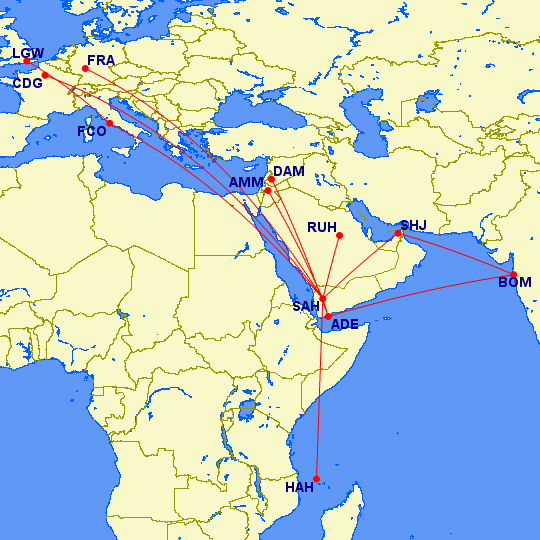 727-200: 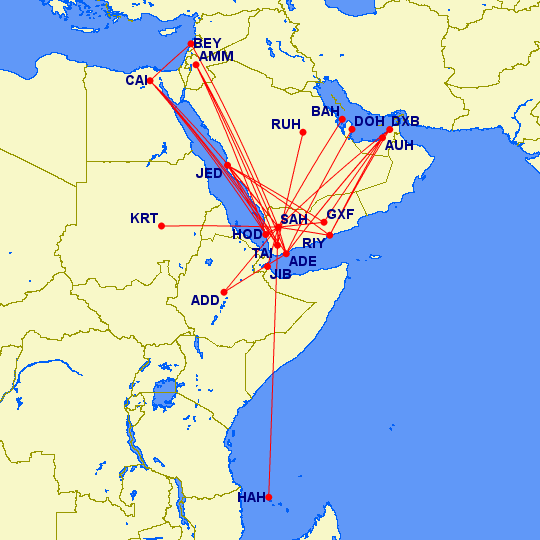 737-200:  DHC-7 Charters: 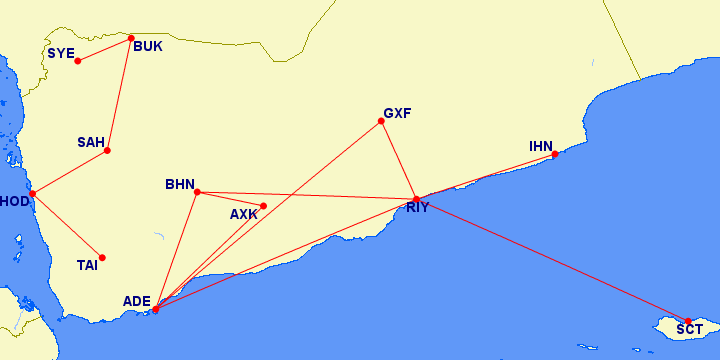 DHC-6 Charters:  IL-76TD Cargo:  L-382 Hercules Cargo: 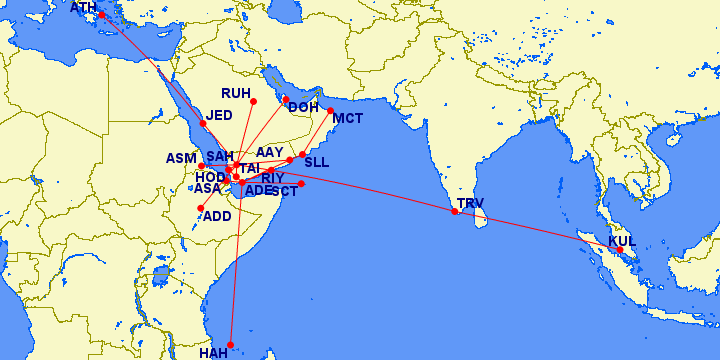 Download Yemenia 1998 v2 Flightplans Download Yemenia 1998 v2 Flightplans |
|
|
|
Post by chasensfo on Dec 16, 2022 5:52:06 GMT -5
//Air Gabon 1998 v3 (16DEC22; Added 727-100 D2-FLY, added fleet livery variations for Michael Pearson's repaints) Air Gabon (1951-2006) IATA: GN ICAO: AGN CALLSIGN: GOLF NOVEMBER Air Service Gabon (1965-2010) IATA: G8 ICAO: AGB CALLSIGN: AIR SERVICE Air Gabon was the national airline of Gabon, based in Libreville(LBV). The carrier was founded initially as Compagnie Aerienne Gabonaise, Gabon's first airline, and operating a Tiger Moth of all random types to start operations. Scheduled flights were started in a few years with De Havilland Dragon Rapide, and the airline had a name change to Societe Nationale Transgabon in 1968 before becoming Air Gabon in 1974. Air Gabon was yet another African airline that took a small fleet and stretched it out over a vast area building a relatively impressive network. In 1998, just about every commercial airport in Gabon was active, and the airline was very creative in tagging on routes to be operated via different cities throughout the week, including the 747 taking a different route to/from Paris(CDG) each day. In its history, the airline operated more than 25 aircraft types, and in 1998, Intra-Africa flying was done by a 727-100(in a leased white livery), a 727-200adv, 2 737-200s, 2 Fokker 28s, and 2 767-200s. In addition, Air Service Gabon operated a CASA 212-200 and a B1900C(in addition to 2 twin Cessnas on charter flights) on behalf of Air Gabon on domestic routes to smaller airports(some of which have since had houses built on the runways). The lone 747-200BM kept very busy, serving several points in Europe as well as Johannesburg twice weekly, and some long-haul routes were also flown by the 767-200s once weekly. Air Gabon failed in 2006, with the government not admitting that the carrier was bankrupt until the sudden and unexpected liquidation announcement, grinding all service to a sudden halt. Since then, many of the airports in these flight plans have not had scheduled commercial air service and therefore may not be AI compatible by default. The CASA 212 and the B1900C operated by Air Gabon are still needed, with all mainline aircraft finished. The following textures are available: Mainline fleet by Michael Pearson: mpai4fs.com/category/repaints/airlines/air-gabon/AIA 767-200 (FS9 Native): On Flightsim.com as "ai76pgab.zip" AIA 727-200 (FS9 Native): library.avsim.net/search.php?SearchTerm=aia_722_air_gabon.zip&CatID=root&Go=SearchFAIB 737-200 by Brian Wheatley: brians-retro-ai.com/repaints/air-gabon-boeing-737-200c/FMAI Fokker 28 (FS9 Native): library.avsim.net/search.php?SearchTerm=aif28airgabon.zip&CatID=root&Go=Search747-200M:  767-200: 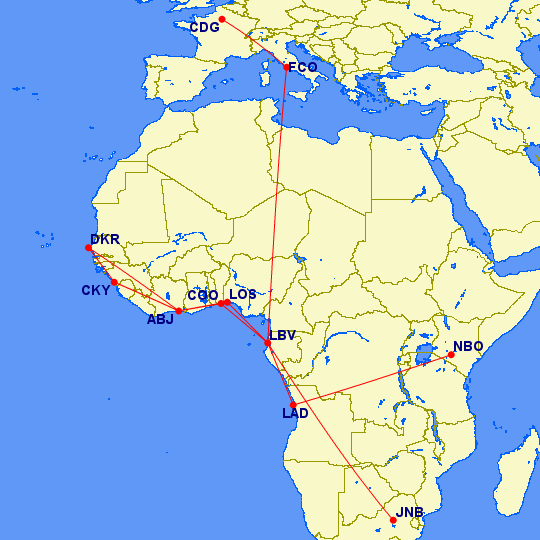 727-100\200:  737-200:  Fokker 28-2000: 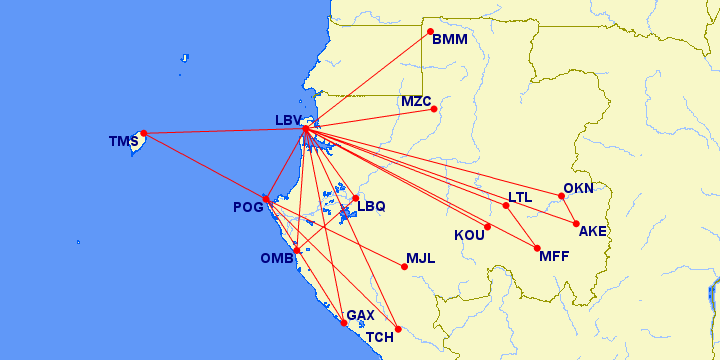 B1900D\CASA 212-200 operated by Air Service Gabon:  Download Air Gabon 1998 v3 Flightplans Here Download Air Gabon 1998 v3 Flightplans Here |
|





































































